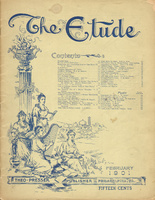The consonants that are made by lip action are about the simplest of all because the action can be so distinctly seen.
The M is somewhat like the N of the previous set, because its resonance lies in the nose, and without which the consonant is impossible. The following phrase: “The new moon is beaming,” spoken with the nose closed, becomes “The dew vood is beating.” The D and B are made entirely without nasal resonance, but the M and N are not.
For illustrating the action of M the following words may be used: Mar, Mourn, Meek, Melt, Mine, Mint, Move, Maim. It will be noticed that for its distinct utterance facility of lip action is very necessary.
The B is somewhat like the D of the previous set, as it is preceded by that peculiar little grunt in the throat, although the quiet tongue gives more room to the resonance. For the B the following words will suffice: Bar, Borne, Beam, Belt, Buy, Bin, Boom, Bake.
The P is the unvocal consonant of the set. It is simply a damming up of the breath by the lips and then exploding it, as it were. It is like the T, except the lips are used for the explosion. For this consonant use the following words: Park, Pour, Peak, Pelt, Pie, Pin, Poor, Pain.
The action of W may be illustrated by the following: War, Worn, Week, Welt, Wise, Win, Woof, Wake. The careful observer will note that this consonant is a swift movement from the lip position of oo to some other vowel. This will be clearly noted by repeating the above words slowly.
Lips and Teeth.
Of the two consonants that are made with the lower lip and the upper teeth, the first, F, is practically unvocal, which will be seen by the following words: Far, Forth, Feel, Felt, Fine, Fin, Fool, Fake.
The V consonant, on the contrary, is vocal, as will be seen by the following words: Varlet, Vortex, Veal, Vex, Vie, Vim, Vow, Vain. In this consonant we have the same little sound back of the tongue that we have in D and B. Repeat the three in succession and the point will be seen: Da, Ba, Va.
Gutturals.
Of the two gutturals the K is the unvocal one, as will be seen by the following list: Car, Call, Keel, Ken, Kick, Kind, Cool, Cane. Of course, the G (hard) and K (hard) are phonetically alike.
The vocal G may be illustrated by Guard, Gall, Grieve, Get, Guy, Gimp, Grew, Gain. This consonant may be compared to the D, B, and V, as will be seen by repeating them all: Da, Ba, Va, Ga.
Lips, Tongue, and Teeth.
The true consonant actions of this set are th, as in think, and th as in those. The following words will illustrate this: (vocal) ‘Those, There, Them; (un-vocal) Thought, Theme, Thigh, Think. The first of these is like the D, B, V, as will be seen by repeating them: De, Be, Ve, the.
The Hissers.
These are two in number: The S, as in sent; and the same as in resemble (or the Z in zone). The Z and hard S are the same phonetically.
The following words illustrate both: (unvocal) Salt, Seal, Sent, Sigh, Since, Soon, Sane; (vocal) Zeal, Zone. De, Be, Ve, The, Ze class together as vocal consonants.
Aspirate.
The H is an aspirate produced by the breath on the vocal chords. Hall, Hate, Hen, Hire, Hoot sufficiently illustrate this.
Two Special Consonants.
The soft G, as in George, is the same as J in John, and is vocal; while the Ch, as in Changes, is an explosive, like the T or P.
Summary.
Vocal consonants: (throat) L(a), B, V, G, Th, Z, J, R,W; (nasal) M, N.
Unvocal consonants: T, P, F, K, Th (soft), S, H, Ch.
The above division, while not necessarily scientific, will, perhaps, serve the purpose of the singer best by reason of its simplicity. In order to understand this classification and make it practical, let the list be repeated both fast and slow, paying the closest attention to the difference between the vocal and the unvocal consonants. In practicing them the utmost care must be taken to use the correct action for each one; and this action must be at once facile and vigorous. The same consonant action which suffices for the studio or parlor is not vigorous enough for a large auditorium.—Perley Dunn Aldrich.



